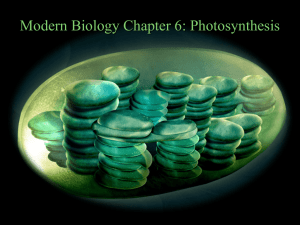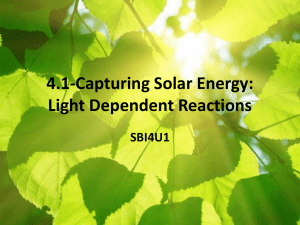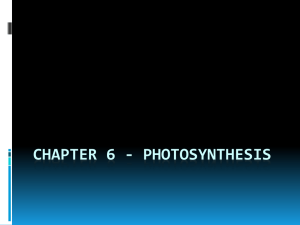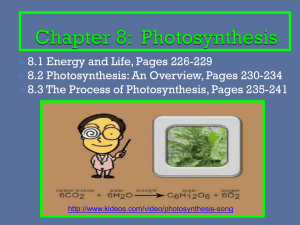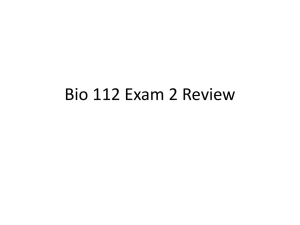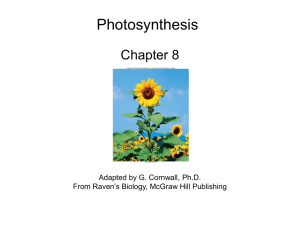Chlorophylls
advertisement
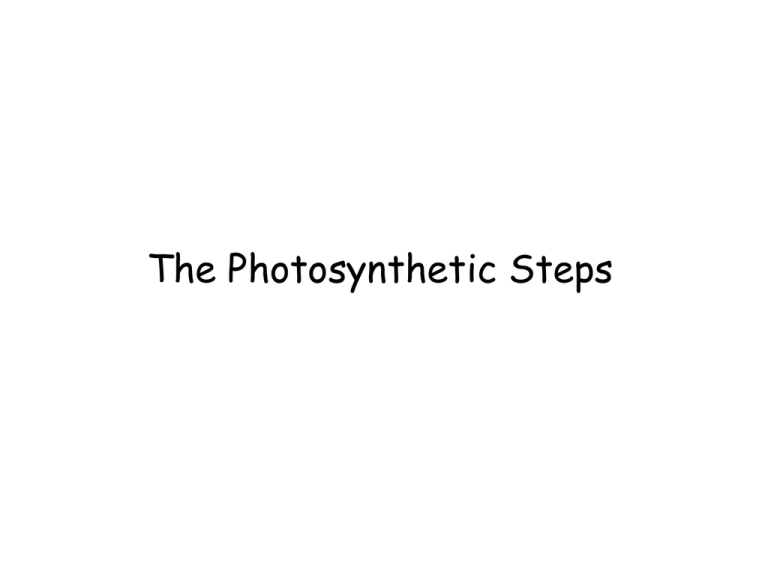
The Photosynthetic Steps Chloroplast synthesize ATP after generation of pH gradient Proton motive force (∆p) from pH gradient generates ATP - Peter Mitchell Two components: a charge gradient and a chemical gradient In mitochondrion, membrane potential plays a major role. In chloroplast, nearly all ∆p is from pH gradient. Because, the thylakoid membrane is quite permeable to Cl- and Mg2+. ex Mg2+ (out) and Cl- (in) upon transfer of H+ into lumen This is in contrast to mitochondria inner membrane Electrical neutrality is maintained and no membrane potential is generated. ATP is generated in stroma Chloroplast ATP synthase: CF1-CF0 complex Closely resembles F1-F0 complex of mitochondria. CF0 conducts protons across the thylakoid membr. CF1 catalyzes ATP formation. CF0: embedded in the thylakoid membrane has four polypeptides: I, II, III and IV with a ratio of 1:2:12:1. I and II similar to subunit b of mito F0. III corresponds to subunit c of mito F0. IV is similar in sequence to subunit a of F0. CF1: the site of ATP sythase has composition α3β3γδε. β contains the catalytic site, 60% identical in amino acid sequence with those of human ATP synthase, despite the passage of 1 billion years since the separation of the plant and animal. ATP is generated in matrix CF1-CF0 membrane orientation is reversed. However, the functional orientation of two enzymes is identical: protons flow from the lumen through the enzyme to the stroma or matrix where ATP is made. Comparison of Chemiosomosis in Chloroplast and Mitochondria FEATURE CHLOROPLAST MITOCHONDRIA membrame involved thylakoid cristae High H+ thylakoid Space Intermembrane space Hydrogen/ Electron donor H2O NADH and Succinate Final electron/hydrogen acceptor NADP to form NADPH O2 to form H20 Nature of reactions Light dependent reaction ETS of aerobic respiration Where ATP is formed stroma matrix e travels from Fdred to cyto. bf to Pc Cyclic photo phosphorylation Reduced Pc is reoxidized by P700+ Cyclic electron flow through Photosystem I leads to production of ATP instead of NADPH When the ratio of NADPH to NADP+ is high, NADP+ is unable to accept electrons from reduced ferredoxin. Instead, the electron in reduced ferredoxin is transferred to the cytochrome bf complex. Then, the e travels to plastocyanin, which can be reoxidized by P700+ to complete a cycle. The net outcome of the cyclic flow of e is pumping protons by cytochrome bf complex Cyclic Electron Transport The resulting proton gradient from cyclic electron transport drives ATP synthesis . The process is called Cyclic photophosphorylation, ATP is generated without NADPH formation. H20 is not making Oxygen – PS II is not working Leads to the synthesis of a higher amount of ATP Overall stoichiometry of the light reactions --Photosystem II needs to absorb 4 photons to generate 1 O2. --This will release 4 protons into the lumen. --2Q + 2 H2O Light O2 + 2QH2. (Photosystem II reaction) --2 molecules of Q are reduced by water to 2 molecules of QH2. -- 2 molecules of QH2 are oxidized by Q cycle of cyto bf to rel. 8 protons into lumen. 2+ 2Q + 4Pc (Cu+) + 4H+ thylakoid lumen -- 2QH2 + 4Pc (Cu ) Light -- 4Pc (Cu+) + 4Fdox 4Pc (Cu2+) +4Fdred (Photosys I react.) --E from 4 of reduced Pc travels to Ferredoxin by abs of 4 photons --Four Fdred (1e carrier) generate 2 NADPH (2e carrier). --Overall: 2H2O + 2NADP+ +10 H+stroma O2 +2NADPH +12 H+lumen Absorption of 8 Photons yields 1 O2, 2 NADPH and 3 ATP 12 protons generated in the lumen will flow through ATP synthase. There are 12 subunit III in CF0 Thus, 12 protons must pass through CF0 to complete one full rotation of CF1. A single rotation generates 3 ATP 2H2O + 2NADP+ +10 H+stroma O2 +2NADPH +12 H+lumen 3ADP3- + 3Pi2- +3H+ +12 H+lumen 3ATP4- + 3H2O + 12 H+stroma _______________________________________________________ 2NADP+ +3ADP3- +3Pi2- +H+ O2 +2NADPH + 3ATP4- + H2O Thus, absorption of 8 Photons yields 1 O2, 2 NADPH and 3 ATP 2.7 photons needed for one ATP Cyclic Photophosphorylation In cyclic electron transport drives cyclic photophosphorylation Photosystem I transfers electrons to plastoquinone (PQ). 4 photons by photosystem I = 8 protons rel into lumen by ETC--- flow of 8 protons through ATP synthase generates 2 ATPs --- Thus 2 photons/ATP – higher yield of ATP production. 8 photons = 12 protons and 3 ATPs = 2.7 photons/ATP- for PSII & I 4e– Ferredoxin PQ Cytochrome complex Photon Pc ATP produced via proton motive force P700 Photosystem I Accessory pigments A light harvesting system only relies on the chlorophyll a molecules of the special pair would be inefficient. Two reasons: 1. Chlorophyll a only absorbs light at specific wavelengths. A large gap between 450 and 650nm The gap region is the peak of the solar spectrum So, failure to absorb the gap region is a huge waste 2. Chlorophyll a density is not very great in the reaction center. Thus, many photos that do not fall in the gap pass through without being absorbed. 3. Thus, accessory pigments, both additional chlorophyll and other pigment (Carotenoid), are closely associated with reaction centers. Photosynthetic Pigments Chlorophylls: Transmit mainly green light Chlorophyll a Chlorophyll b Carotenoids: Transmits mainly orange, yellow or red Chlorophyll Chlorophyll: similar to that of the heme group of myoglobin, hemoglobin, and cytochromes in center tetrapyrrole ring A long hydrophobic side chain (phytol group) Mg2+ 4 isoprenoid units binding to hydrophobic region of thylakoid membrane chlorophyll a: methyl group chlorophyll b: aldehyde group CHO in chlorophyll b H2C Ring Structure In Head Absorbs Light CH3 in chlorophyll a CH H3C N N CH2CH3 Mg N N CH3 H3C CH2 CH2 C COCH3 O OO O CH2 Tail Carotenoids CH3 CH3 Accessory Pigment Present in Light Harvesting Complexes H3C CH -carotene H3C CH CH3 CH3 HO Different Pigments Absorb Different Wavelengths of Light Every pigment has a characteristic Absorption Spectrum Amount of light absorbed Chlorophyll a (Absorbs light between 450 and 500nm) Chlorophyll b (responsible for yellow and red colors of plants) Carotenoids 400 500 600 Wavelength of light (nm) 700 Properties of Light absorption When a pigment absorbs a wavelength of light, you do not see that color! Chlorophyll a and b absorb light with wavelengths <500nm (blue) and >600nm (orange or red). Thus, we do not see these colors. Chlorophyll a and b do not absorb light with wavelength between 500-600nm, which is green region. Thus, we mainly see green color. Carotenoids do not absorb light with wavelength longer than 600nm (orange and red). In summer, Chlorophyll a and b are domainant, absorbing light with wavelength <500nm (blue) and >600nm (orange or red). Thus, we do not see these colors. We see green color (500-600nm), instead. In fall, Chlorophylls are degraded. Carotenoids are dominant. Since they do not absorb light with wavelength longer than 600nm, plants are orange or red. Loss of chlorophyll The carotenoids are responsible for the brilliance of fall, when the Chlorophyll molecules are degraded. Resonance Energy Transfer Energy transfer 1st donor chromophore 1st acceptor chromophore Energy transfer 2nd donor chromophore 2nd acceptor chromophore The absorp of a photo does not always lead to e excitation and transfer. More commonly, excitation energy is transferred from one mol. to a nearby mol. through electromagnetic interactions through space. (Resonance Energy Transfer) RET depends strongly on the distance between energy donor and acceptor. An increase of 2 results in a decrease in the energy transfer rate by a factor of 26 = 64. RET must be from a donor in the excited state to an acceptor of equal or lower energy. Energy transfer from accessory pigments to reaction centers Carotenoid Accessory chlorophyll Light energy absorbed by accessory chlorophyll or other pigments can be transferred to reaction centers, where it drives photoinduced charge separation. The excited state of special pair of chlorophyll mol. is lower in energy than that of single chlorophyll mol., allowing reaction centers to trap the energy transferred from other mole. Protein Bacterial Light-harvesting complex The accessory pigments are arranged in many light-harvesting complexes surround the reaction center. Eight polypeptides Each polypeptide binds 3 chlorophyll mol. 1 carotenoid mol. Chlorophyll Reaction center Carotenoid Localization of photosynthesis components Stacking (appressed) increases surface area Unstack (non-appressed) regions make direct contact with stroma PS I and ATP synthase locate in unstacked regions PS I is given direct access to the stroma for the reduction of NADP+. ATP synthase is provided enough space for its large CF1 globule and access to ADP PS II mainly in stack regions. The tight quarters of these region pose no problem for PS II, which interacts with a small polar e donar (H2O) and a lipid soluable e carrier (plastoquinone). Cytochrome bf in both regions Plastocyanin and plastoquinone mobile carriers A common internal lumen enables protons released by PS II in stacked region to be used by ATPase located in unstacked region. Inhibitors Kill weeds by inhibiting PS II or PS I Diuron (urea derivative) Bind QB site of PS II Prevent formation of plastoquinol QH2. Paraqat Targets PS I Accept electrons from PS I Becomes a radical Reacts with O2 to produce ROS (O2and OH ) Damages membrane lipids double bonds . . Problems Weed killer DCMU. DCMU (dichlorophenyldimethylurea), a herbicide, interferes with Photophosphorylation and O2 evolution. However, it does not block O2 evolution in the Presence of an artificial e acceptor such as ferricyanide. a) Propose a site for the inhibitory action of DCMU. A: --- DCMU inhibits e transfer in the link between photosystem II and I. --- O2 can evolve in the presence of DCMU if an artificial e acceptor such as ferricyanide can accept electrons from Q. b) Predict the effect of DCMU on a plant’s ability to perform cyclic photophosphorylation. A: No effect. Because it blocks photosystem II, and cyclic photophosphorylation use Photosystem I and the cytochrome bf complex. DCMU Problems-continued Hill reaction. In 1939, Robert Hill discovered that chloroplasts evolve O2 when they are Illuminated in the presence of an artificial electron acceptor such as ferricyanide [Fe3+(CN)6]3-. Ferricyanide is reduced to ferrocyanide [Fe2+(CN)6]4- in this process. No NADPH or reduced plastocyanin is produced. Propose a mechanism for the Hill reaction . A: The electrons flow through photosystem II directly to ferricyanide. No other steps are required. Close approach. Suppose that energy transfer between two chlorophyll a molecules separated by 10A takes place in 10picoseconds. Suppose that this distance is increased to 20A with all other factors remaining the same. How long would energy transfer take? A: The distance doubles, and so the rate should decrease by a factor of 64 to 640ps. Ferricyanide can accept e here Problems-continued Photochemical Efficiency of Light at Different Wavelengths. The rate of photosynthesis, measured by O2 production, is higher when a green plant is Illuminated with light of wavelength 680nm than with light of 700nm. However, Illumination by a combination of light at 680nm and 700nm gives a higher rate of photosynthesis than light of either wavelength alone. Explain. A: For the maximum photosynthetic rate, photosystem I (which absorbs light of 700nm) and photosystem II (which absorbs light of 680nm) must be operating simultaneously. Effect of Monochromatic Light on Electron Flow. The extent to which an e carrier is oxidized or reduced during photosynthetic e transfer can sometimes be observed directly with a spectrophotometer. When chloroplasts are illuminated with 700nm light, cytochrome f, plastocyanin, and plastoquinone are oxidized. When chloroplasts are illuminated with 680nm light, however, these e carriers are reduced. Explain. A: Light of 700nm excites photosystem I but not photosystem II. E flow from P700 to NADP+, but no e flow from P680 to replace them. When light of 680nm excites photosystem II, e tend to flow to photosystem I, but the e carriers between the two photosystems quickly become completely reduced. Problems-continued Function of Cyclic Photophosphorylation. When the [NADPH] / [NADP+] ratio in chloroplasts is high, photophosphorylation is Predominantly cyclic. a) Is O2 evolved during cyclic photophosphorylation? Explain. A: No. The excited electron from P700 returns to refill the electron “hole” created by illumination. Photosystem II is not needed to supply electrons, and no O2 is evolved from water. b) Can the chloroplast produce NADPH in this way? A: No NADPH is formed, because the excited electrons returns to P700. c) What is the main function of cyclic photophosphorylation? A: Cyclic photophosphorylation occurs when the plant cell is already amply supplied with reducing power in the form of NADPH but requires additional ATP for other metabolic needs. Thus, a plant can adjust the ratio of NADPH and ATP to match the needs of these products in energy-requiring processes. Problems-continued Effect of DNP Predict the effect of an uncoupler such as dinitrophenol on production of ATP and NADPH in a chloroplast. a) ATP A: An uncoupler dissipates the transmembrane proton gradient by providing a route for proton translocation other than ATP synthase. Thus, chloroplast ATP production would decrease. b) NADPH A: The uncoupler would not affect NADP+ reduction since light-driven electron transfer reactions would continue regardless of the state of the proton gradient. More photon absorption. Why is it possible for chloroplasts to absorb more than 8 photons per O2 evolved? A: ---When cyclic electron flow occurs, photoactivation of PSI drives electron transport independently of the flow of electrons derived from water. ---Thus, the oxidation of water by PSII is not linked to the no of photons consumed byPSI. Problems-continued Radioactive labelling H218O is added to a suspension of chloroplasts capable of photosynthesis. Where does the label appear when the suspension is exposed to light? Why A: ---The label appears as 18O2. ----2 H218O + 2NADP+----2NADPH + 2H+ + 18O2 Reaction order The three e-transport complexes of the thylakoid membrane can be called plastocyaninferredoxin oxidoreductase, plastoquinone-plastocyanin oxidoreductase, and water-plasto quinone oxidoreductase. a) What are the common names of these enzymes? A: plastocyanin-ferredoxin oxidoreductase: Photosystem I plastoquinone-plastocyanin oxidoreductase: Cytochrome bf water-plastoquinone oxidoreductase: Photosystem II a) In what order do they act? Water-plastoquinone oxidoreductase---- plastoquinone-plastocyanin oxidoreductase ----- plastocyanin-ferredoxin oxidoreductase, Problems-continued Red tide. The “red tide” is a massive proliferation of certain algal species that causes Seawater to become visibly red. Describe the spectral characteristics of the dominant Photosynthetic pigments in the algae. A: The color of the seawater indicates that the photosynthetic pigments of the algae absorb colors of visible light other than red. Carotenoids, rather than Chlorophylls, are the likely pigments. More DCMU DCMU blocks photosynthetic e transport from PSII to the cytochrome bf. a). When DCMU is added to isolated chloroplasts, will both O2 evolution and photophosphorylation cease? A: YES. ---- When DCMU locks e flow, PSII in the P680* state will not be reoxidized to the P680+ state, which is required as an acceptor of electrons from water. ---If water is not oxidized by P680+, then no O2 will be produced. ---In the absence of e flow through cytochrome bf, no protons will be translocated. ---Without a proton gradient, ATP will not generated. b). If an external e acceptor that reoxidizes P680* is added, how will this affect O2 Productiion and photophosphorylatiion? A: External e acceptor for PSII will permit P680* to be oxidized to P680+, thus restore O2 evolution. No e will flow through the cytochrome bf, however, so that no photophosphorylation will occur. Problems-continued In vitro ATP synthesis. a) The luminal pH of chloroplasts suspended in a solution of pH 4.0 reaches pH 4.0 within a few minutes. Explain why there is a burst of ATP synthesis when the pH of the external solution is quickly raised to pH 8.0 and ADP and Pi are added. A: -When the external pH rises to 8.0, the stromal pH also rises quickly, but the luminal pH remains low because the thylakoid membrane is relatively impermeable to protons. --The pH gradient across the thylakoid membrane drives the production of ATP via proton translocation through chloroplast ATP synthase. b) If ample ADP and Pi are present, why does ATP synthesis cease after a few seconds? A: ----Protons are transferred from the lumen to the stroma by ATP synthase, driving ATP synthesis. ----The pH gradient across the membrane decreases until it is insufficient to drive the phosphorylatiion of ADP, and ATP synthesis stops.
